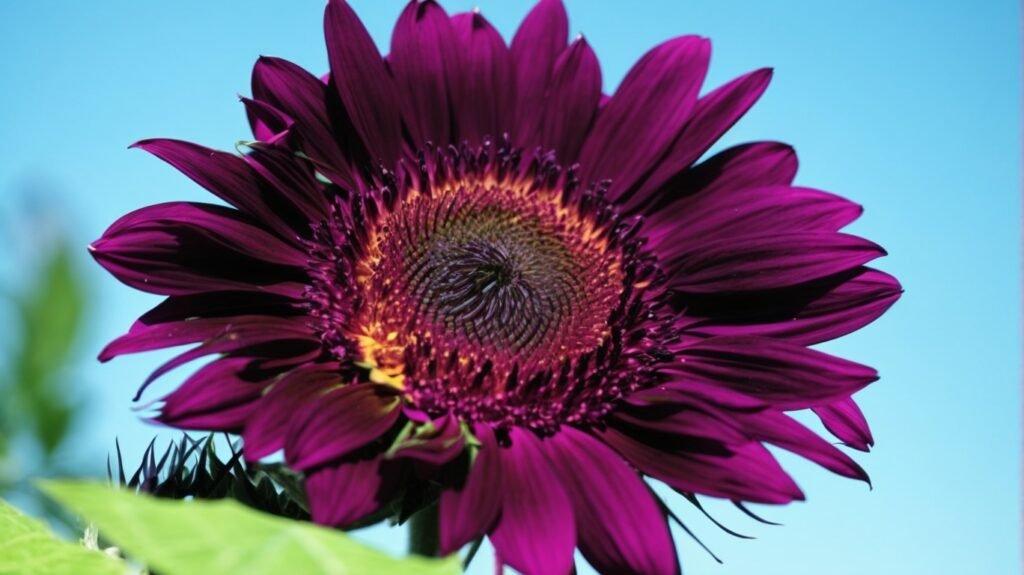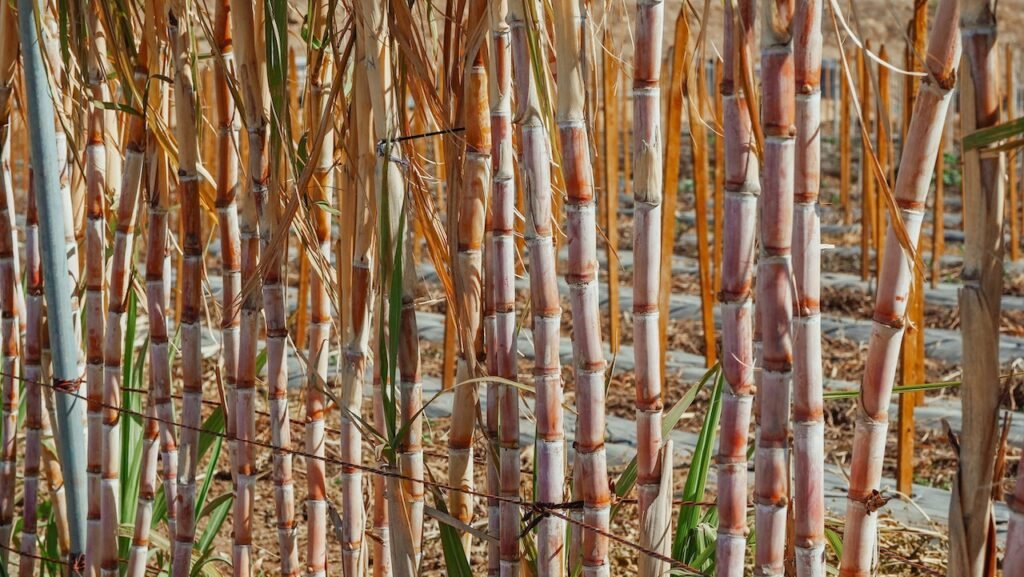
Imagine a vibrant garden filled with a sea of purple sunflowers, their petals reaching towards the sky like rays of sunshine on a summer’s day. If you’ve ever wondered how to bring this enchanting beauty into your own backyard, you’ve come to the right place.
In this guide, we will walk you through the process of growing purple sunflowers from seed to flower, sharing valuable tips and expert advice along the way.
So, whether you’re a seasoned gardener looking to add a touch of uniqueness to your collection or a beginner eager to embark on a new botanical journey, join us as we uncover the secrets of cultivating these captivating blooms.
Key Takeaways
- Purple sunflowers add elegance and sophistication to gardens or floral arrangements.
- They require full sun and well-drained soil with a pH level between 6.0 and 7.5.
- Regular pest control measures are necessary for healthy growth.
- Harvest the flower heads when fully matured and use them in various crafts or extract sunflower oil from the seeds.
What are Purple Sunflowers?
Purple sunflowers are a unique and captivating variation of the traditional sunflower. They come in different types, each with its own distinct shade of purple, ranging from deep violet to lavender. These vibrant colors make them stand out in any garden or floral arrangement.
Purple sunflowers hold significant symbolism, representing mystery, creativity, and spirituality. They add a touch of elegance and sophistication to any landscape. To grow purple sunflowers successfully, certain conditions are essential. They thrive in full sun, requiring at least 6-8 hours of direct sunlight daily. Well-drained soil with a pH level between 6.0 and 7.5 is ideal.
Like their traditional counterparts, purple sunflowers are susceptible to common pests such as aphids, caterpillars, and slugs. Regular monitoring and appropriate pest control measures are necessary to ensure the plants remain healthy and pest-free.
Growing purple sunflowers in containers is also possible. Choose a large pot with good drainage and fill it with a well-balanced potting mix. Regular watering and fertilization are crucial for their growth and development.
How to Grow Purple Sunflowers?
To successfully grow purple sunflowers, there are several important factors to consider. Here is a list of key considerations for growing these vibrant and unique flowers:
- Purple Sunflower Varieties: Choose from a range of purple sunflower varieties, such as ‘Purple Disk’ or ‘Velvet Queen’, which exhibit stunning shades of purple in their petals. Select a variety that suits your climate and personal preferences.
- Soil Requirements: Purple sunflowers thrive in well-draining soil that’s rich in organic matter. Prepare the soil by loosening it and adding compost or well-rotted manure to improve its fertility. Aim for a slightly acidic to neutral pH level.
- Watering Needs: Purple sunflowers require regular watering, especially during dry spells. Keep the soil evenly moist, but avoid overwatering, as this can lead to root rot. Mulching around the plants can help retain soil moisture.
- Common Pests: While purple sunflowers are relatively resistant to pests, they can still be affected by aphids, slugs, and snails. Monitor your plants regularly and take necessary measures, such as using organic insecticides or physical barriers, to protect them from potential damage.
- Sunflower Companion Plants: Consider planting companion plants, such as marigolds or zinnias, alongside your purple sunflowers. These plants can attract beneficial insects, repel pests, and enhance the overall visual appeal of your garden.
How to Care for Purple Sunflowers
For optimal growth and health, purple sunflowers require diligent care and attention throughout their lifespan. To ensure your purple sunflowers thrive, it’s essential to be aware of common issues such as sunflower pests and diseases.
Regular monitoring of your plants can help you spot any signs of infestation or disease early on. Some common sunflower pests include aphids, caterpillars, and slugs. These can be controlled by using insecticidal soaps or organic pesticides.
Sunflower diseases such as powdery mildew and downy mildew can be prevented by providing good air circulation and avoiding overhead watering.
Watering is an important aspect of caring for purple sunflowers. They require regular watering, especially during hot and dry weather. It’s important to water deeply, ensuring the soil is moist but not waterlogged.
Fertilizing your purple sunflowers is also crucial for their growth and blooming. Use a balanced fertilizer with equal amounts of nitrogen, phosphorus, and potassium. Apply the fertilizer according to the package instructions.
Finally, pruning can help promote healthy growth and prevent the plant from becoming too leggy. Trim back any dead or damaged leaves, as well as any overcrowded branches.
Where and When to Plant Purple Sunflowers
To ensure successful growth and blooming of your purple sunflowers, it’s important to carefully consider the location and timing of planting. Here are some key factors to keep in mind:
- Planting locations: Purple sunflowers thrive in well-drained soil with a pH level between 6.0 and 7.5. Choose a location that receives full sun for at least 6-8 hours a day. It’s important to avoid areas with excessive shade or strong winds that can damage the delicate flowers.
- Ideal planting time: Purple sunflowers are warm-season plants and should be planted after the last frost has passed. The ideal time to sow the seeds is in late spring or early summer when the soil has warmed up. This ensures that the seeds germinate quickly and the plants grow vigorously.
- Soil requirements: The soil should be rich in organic matter and have good drainage. Prior to planting, work the soil well and remove any weeds or debris. Adding compost or well-rotted manure can improve soil fertility and provide essential nutrients for the plants.
- Watering needs: Purple sunflowers require regular watering, especially during dry periods. However, it’s important to avoid overwatering, as this can lead to root rot. Water the plants deeply, ensuring that the soil is evenly moist but not waterlogged.
- Sunlight exposure: Purple sunflowers are sun-loving plants and thrive in full sunlight. Make sure to plant them in an area that receives ample sunlight throughout the day. Insufficient sunlight can result in weak, leggy plants with fewer blooms.
Harvesting and Using Purple Sunflowers
Harvesting and using purple sunflowers offers a range of opportunities to enjoy their vibrant beauty and utilize their unique characteristics in various ways. When it comes to harvesting methods, it is important to wait until the flower heads have fully matured and the back of the head turns yellow. At this stage, the seeds will be plump and ready for harvest. To preserve sunflower seeds for future use, you can simply air dry them by placing the flower heads in a warm, dry location. Alternatively, you can also roast the seeds for a delicious and nutritious snack.
But the uses of purple sunflowers don’t stop at the seeds! These stunning flowers can also be incorporated into various sunflower crafts. From floral arrangements and wreaths to pressed flower art, the vibrant purple petals add a unique touch to any project. Additionally, purple sunflowers have their own set of benefits. They not only attract bees and butterflies to your garden, but they also serve as a natural dye source, providing a beautiful purple hue for fabrics and crafts.
Another interesting aspect of purple sunflowers is their potential for sunflower oil extraction. The seeds contain a high amount of oil, making them a valuable source for homemade oils. By using a cold-press method, you can extract the oil from the seeds and use it for cooking or skincare purposes. Overall, harvesting and using purple sunflowers allows you to appreciate their beauty, explore creative endeavors, and benefit from their versatile characteristics.

To summarize, here is a table highlighting the different uses and benefits of purple sunflowers:
| Uses of Purple Sunflowers | Benefits of Purple Sunflowers |
|---|---|
| Harvesting sunflower seeds | Attract bees and butterflies |
| Sunflower crafts | Natural dye source |
| Sunflower oil extraction | High oil content in seeds |
With these options, you can make the most of your purple sunflowers and enjoy their beauty in a multitude of ways.
Tips for Growing Healthy Purple Sunflowers
When cultivating vibrant and healthy purple sunflowers, it’s essential to prioritize proper care and maintenance throughout their growth cycle. To ensure the success of your sunflower garden, consider the following tips:
- Watering Techniques: Sunflowers require regular watering, especially during dry spells. Water deeply and thoroughly, ensuring the soil is moist but not waterlogged. Avoid overhead watering to prevent fungal diseases.
- Soil Requirements: Purple sunflowers thrive in well-drained soil with a pH level between 6.0 and 7.5. Prior to planting, amend the soil with organic matter to improve its fertility and drainage. Ensure the soil is loose and friable for healthy root development.
- Pest Control: Protect your sunflowers from common pests like aphids, caterpillars, and snails by regularly inspecting the leaves and stems. Consider using organic insecticides or natural pest control methods to minimize damage.
- Sunflower Varieties: Choose sunflower varieties that are known for their purple blooms, such as ‘Chianti’ or ‘Purple Majesty’. These varieties will add a stunning pop of color to your garden.
- Pruning Methods: Pruning sunflowers isn’t necessary, but it can promote better air circulation and reduce the risk of disease. Remove any dead or damaged leaves, and trim back branches that are crowding the plant.
Frequently Asked Questions
Can Purple Sunflowers Be Grown Indoors?
Yes, you can grow purple sunflowers indoors. They thrive in containers, but make sure to provide them with enough sunlight by placing them near a sunny window. Control the temperature and choose well-draining soil for optimal growth.
Do Purple Sunflowers Attract Bees and Other Pollinators?
Attracting bees and other pollinators to your garden is crucial for plant reproduction. Bees play a vital role in transferring pollen, ensuring the growth of fruits and flower seeds. Creating a pollinator-friendly garden with native plants is key to their attraction and survival.
Are Purple Sunflowers Resistant to Common Garden Pests and Diseases?
Purple sunflowers are known for their resistance to common garden pests and diseases. With their natural pest control mechanisms, they can prevent pest infestations, protecting the health and beauty of your garden.
How Long Does It Take for Purple Sunflowers to Bloom?
It typically takes purple sunflowers around 70-90 days to bloom. The blooming time can be influenced by factors such as temperature, sunlight, soil quality, and proper care. Avoiding common mistakes and providing optimal growing conditions can help extend the blooming period.
Can Purple Sunflowers Be Used for Floral Arrangements or Dried Flower Crafts?
You’ll be thrilled to know that purple sunflowers make a stunning addition to wedding bouquets and can be creatively used in dried flower crafts. DIY wreaths, preserved vibrant color, and home decor are all possibilities.
Conclusion
Congratulations! You have embarked on a journey to grow the majestic purple sunflowers. By following the steps outlined in this guide, you have learned how to nurture these vibrant beauties from seed to flower.
Remember to provide them with ample sunlight, well-drained soil, and regular watering. Soon, your garden will be adorned with these stunning allegories of beauty and resilience.
Embrace the joy of watching them bloom, knowing that you have played a part in their magnificent transformation.
Happy gardening!

